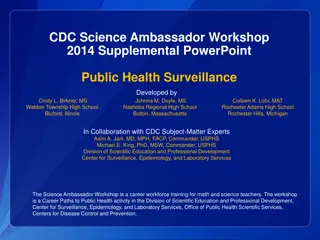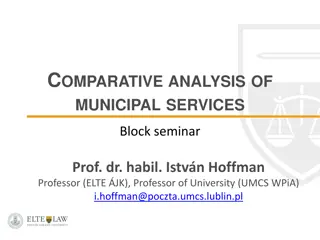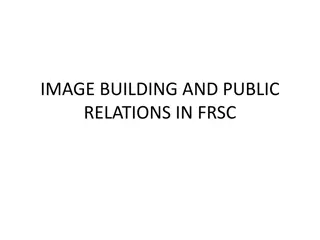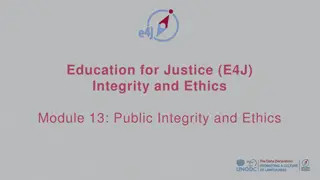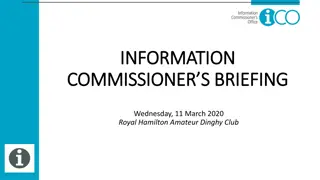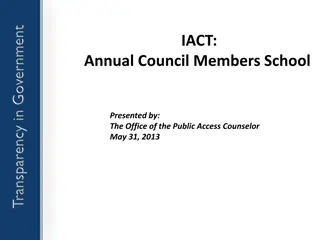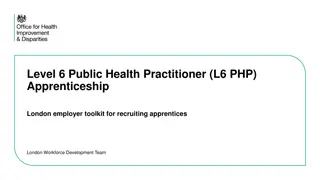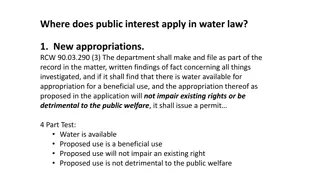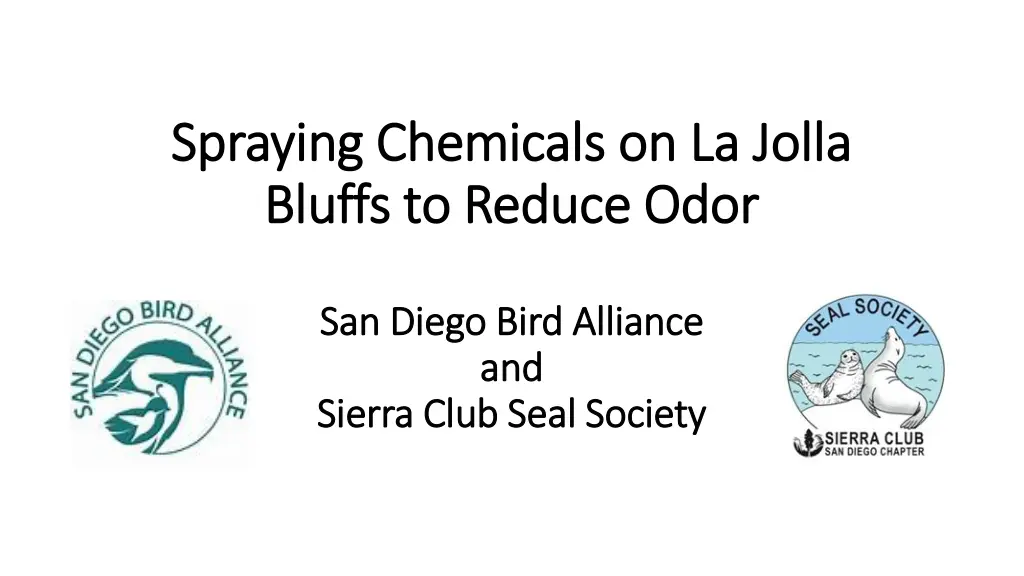
Reducing Odor on La Jolla Bluffs with Chemical Spraying - Safety Concerns
Discover the use of chemicals on La Jolla Bluffs to reduce odor and the associated safety hazards. Learn about the organizations involved, potential environmental impacts, and safety measures. Explore safety data sheets, hazard classifications, and product information.
Download Presentation

Please find below an Image/Link to download the presentation.
The content on the website is provided AS IS for your information and personal use only. It may not be sold, licensed, or shared on other websites without obtaining consent from the author. If you encounter any issues during the download, it is possible that the publisher has removed the file from their server.
You are allowed to download the files provided on this website for personal or commercial use, subject to the condition that they are used lawfully. All files are the property of their respective owners.
The content on the website is provided AS IS for your information and personal use only. It may not be sold, licensed, or shared on other websites without obtaining consent from the author.
E N D
Presentation Transcript
Spraying Chemicals on La Jolla Spraying Chemicals on La Jolla Bluffs to Reduce Odor Bluffs to Reduce Odor San Diego Bird Alliance San Diego Bird Alliance and and Sierra Club Seal Society Sierra Club Seal Society
SMR Area on bluffs where chemicals are sprayed, and birds, who are high conservation priority, nest, and the Matlahuayl SMR (State Marine Reserve), a marine protected area, is located directly below. Photo by Robyn Davidoff
Pubchem 1,2-Benzisothiazol-3(2H)-one 2011. Safety and Hazards H302: Harmful if swallowed [Warning Acute toxicity, oral] H315: Causes skin irritation [Warning Skin corrosion/irritation] H317: May cause an allergic skin reaction [Warning Sensitization, Skin] H318: Causes serious eye damage [Danger Serious eye damage/eye irritation] H400: Very toxic to aquatic life [Warning Hazardous to the aquatic environment, acute hazard] GHS Hazard Statements https://pubchem.ncbi.nlm.ni h.gov/
Safety Data Sheet revised 9/29, 2014 BioActive Microbial Odor Counteractant and Cleaner Product Code: BAMOCC Decomposition products: Possible oxides of carbon (CO, CO2) Toxic to aquatic life revised 9/29, 2014 Blue Eagle Causes eye irritation. Wear eye protection and gloves while handling this product GHS Precaution Phrases: Skin irritation Wash hands thoroughly after handling. Indigestion: May be harmful if swallowed. Wash hands thoroughly after handling, get medical attention immediately if severe GHS Response Phrases: Possible nausea, stomach discomfort, diarrhea, headache, dizziness, do not Induce vomiting unless directed by a physician
SAFETY DATA SHEET BIOACTIVE ODOR COUNTERACTANT AND SAFETY DATA SHEET BIOACTIVE ODOR COUNTERACTANT AND CLE CLEANER (BIOCAAC) Revision 1 ANER (BIOCAAC) Revision 1 Revision Date: 16 Revision Date: 16- -JUN ARK ENVIRONMENTAL SOLUTIONS , INC. 12 Sandpiper Strand Coronado, CA 92118, ARK ENVIRONMENTAL SOLUTIONS , INC. 12 Sandpiper Strand Coronado, CA 92118, +1 (619) 251 3553 lance@arkenviro.com +1 (619) 251 3553 +1 (619) 251 3553 lance@arkenviro.com +1 (619) 251 3553 JUN- -2020, excerpt 2020, excerpt HAZARDS IDENTIFICATION Section 3- Hazard Classification (29 CFR 1910.1200) Skin Sensitization / Subcategory 1A This product is considered hazardous by the 2012 OSHA Hazard Communication Standard Hazardous Decomposition Products Carbon oxides (CO and CO2) Product Information for Inhalation, Eye Contact, Skin Contact, Ingestion Component Information may cause sensitization by skin contact. Specific test data for the mixture is not available. There is no mention of toxic to an aquatic environment.
Surfactant Added to the Chemical BIOCAAC before Spraying Surfactant is added to the liquid spray product to create the foaming action that increases the dwell time on the bluffs and reduces running. If contamination with surfactant causes the surface tension of seawater to drop below normal, water will fail to form droplets and will penetrate the feather lattice structure of a bird s plumage and it will become waterlogged (Swennen 1977).




